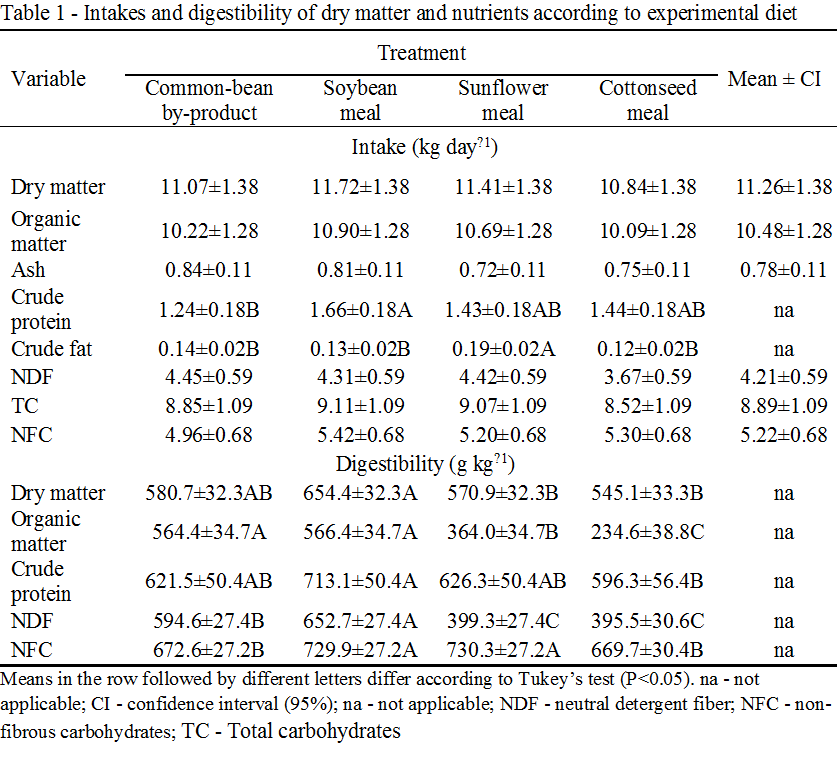
Consumo e digestibilidade de nutrientes de vacas leiteiras suplementadas com diferentes fontes proteicas
2 - SENAR - MT
3 - Universidade Federal de Goiás - GO
4 - Universidade Federal de São João del-Rei - MG
5 - Universidade Federal Rural do Rio de Janeiro - RJ
6 - Universidade Federal de São João del-Rei - MG
7 - Universidade Federal de Mato Grosso - MT
8 - Instituto Federal de Educação, Ciência e Tecnologia do Tocantins - TO
RESUMO -
O objetivo deste estudo foi avaliar a suplementação de vacas leiteiras com diferentes fontes protéicas alternativas sobre variáveis relacionadas ao consumo e digestibilidade de nutrientes. Oito vacas mestiças (Holandes × Gir) foram distribuídas em dois quadrados latinos simultâneos (4 × 4). Os tratamentos testados foram os seguintes: resíduo da colheita do feijão, farelo de soja, farelo de girassol e farelo de algodão. As estruturas de variância-covariância foram testadas pelo critério de Akaike corrigido para determinar o melhor ajuste de dados. Os tratamentos influenciaram apenas a ingestão de matéria seca, proteína bruta e gordura bruta. Considerando a digestibilidade, independentemente da variável avaliada, a farelo de soja foi um dos tratamentos mais eficientes. O farelo de soja mostrou-se o mais adequado, entretanto o subproduto de feijão pode ser uma alternativa interessante em regiões onde este alimento é encontrado em grandes quantidades.
Nutrient intake and digestibility of dairy cows supplemented with different protein sources
ABSTRACT - The objective of this study was to evaluate the supplementation of dairy cows with different alternative protein sources on nutrient intake and digestibility. Eight crossbreed cows (Holstein × Gyr) were distributed into two simultaneous 4 × 4 Latin squares. The following treatments were tested: common-bean by-product, soybean meal, sunflower meal, and cottonseed meal. Variance-covariance structures were tested by corrected Akaike’s criterion to determine the best data adjustment. Treatments only influenced the intakes of dry matter, crude protein, and crude fat. Considering the digestibility, irrespective of the variable evaluated, soybean meal was the best or one of the most efficient treatments. Soybean meal is the most suitable, but the common-bean by-product may be an interesting alternative in regions where this food is found in large quantities.Introdução
Aiming at lower production costs for animal products, rational use of all food sources has been significantly emphasized in the present days. In this way, several by-products from agriculture and/or animal production, when employed in a rational manner, can contribute to reducing the costs of animal feeding (CARVALHO JÚNIOR et al. 2010).
By-products and wastes originating from the processing of grains are a promising alternative to reduce the feeding costs of dairy animals. Sensible use of these products depends on their nutritional properties and other factors (PEREIRA, 2000).
The protein is considered an expensive nutritional ingredient, and, in most cases, the nutrient of highest quantitative requirement. For these reasons, the protein is an important object of studies aimed at increasing its use efficiency through strategic utilization, or substitution of the traditionally used feedstuffs for others with better cost-benefit ratio.
The goal this study was to evaluate the effect of supplementing dairy cows with different protein sources (soybean meal, cottonseed meal, sunflower meal, and common-bean by-product) on nutrient intake and digestibility.
Revisão Bibliográfica
In dairy cows, the source of protein is usually the highest cost food and soybean meal is the most used source, by large and small producers. Soy is a food that presents price changes due to the international market, as well as being widely used in food, non-ruminant feed, as well as in the chemical industry and, more recently, as an alternative source of fuel (EMBRAPA, 2010).
One of the great advantages of ruminants is converting sources of uncompetitive and low quality food into high quality protein for human consumption. Therefore, the protein supply in quantitative and qualitative terms deserves to be highlighted by the high nutrient requirement and the variability of the response to the different sources of nitrogen compounds available (NRC, 2001).
It is important to search for alternative food that can be used on farms, these foods should be cheap, bringing profit for the activity to be competitive when compared to other crops.
Replacing soybean meal with alternative sources of protein without reducing animal performance may be an interesting alternative to reduce the costs of feeding dairy cows. However, the possibility of using these ingredients in ruminant diets requires careful, strategic, technical and financial assessments and analyzes (PINA et al., 2006).
Materiais e Métodos
Eight crossbred cows (Holstein × Gyr) with an average weight of 554.59±30.43 kg, milk yield of 14.85±3.28 kg/day, and at 60 to 90 days in milk were used in this experiment. The animals were kept in paddocks with signal grass (Brachiaria brizantha cv. MG5) equipped with drinkers and troughs in a rotational grazing system.
Cows were distributed into two simultaneous 4 × 4 Latin squares. The experiment lasted 84 days, and each period had 21 days, with the first 14 days used for adaptation and the others seven days for data collection.
Treatments were formulated as follows: soybean meal, cottonseed meal, sunflower meal, and common-bean by-product. The diets were formulated according to the production requirements of the animals and in accordance with the recommendations of NRC (2001). The quantities of feed supplied and refusals from each animal were recorded to estimate the intake. After analysis, dry matter, crude protein, crude fat, ash, and neutral detergent fiber, total carbohydrates and non-fibrous carbohydrates were estimated.
To calculate the excreted fecal matter, chromic oxide (Cr2O3) was used as an external marker. Feces were collected on the 16th, 18th, and 20th days of each experimental period, twice daily, at 08.00 h and 16.00 h, directly from the rectum of the animals. Subsequently analyzed for the chromium content on an atomic absorption spectrophotometer, according to the method described by Williams et al. (1962).
Indigestible neutral detergent fiber (iNDF) was employed to determine the dry matter intake. The excretion of nutrients was obtained as the fecal excretion of dry matter multiplied by the concentration of nutrients in the feces.
The likelihood of the different variance-covariance structures was assessed by computing Akaike’s information criterion (Akaike 1974) as suggested by Vieira et al. (2012). Treatment means were compared by Tukey’s test at 5% probability level.
Resultados e Discussão
Only the intakes of dry matter, crude protein, and crude fat were influenced by the different diets proposed, while the other variables were not significantly affected (Table 1).
Crude protein intake was higher for the cows that received soybean meal in relation to the common-bean by-product, while the others showed an intermediate response. Considering CF intake, sunflower meal was superior to the others, which did not present different values.
The investigation of the best variance-covariance structures, based on corrected Akaike’s criterion, reveals that the errors are mutually correlated in some cases. This indicates that data may be completely misanalyzed when independence of the errors is assumed in simultaneous Latin square designs (Akaike 1974; Jardim et al. 2013; Vieira et al. 2012).
Pina et al. (2006) evaluated the nutrient intake by cows fed diets containing different protein sources such as soybean meal and cottonseed meal and did not observe differences in the intakes of dry matter and organic matter, which corresponds to the response observed in the present study. On the other hand, Magalhães et al. (2008) reported that the common bean has an extended time of colonization of its fibrous part (lag time), which slows the fiber degradation, leading to lower flow in the gastrointestinal tract of the animals, which in turn may affect their intake. This response could be little detectable due to the low fiber level in the treatment with common-bean by-product, but, in this case, the fiber quality is as important as its quantity.
Table 1 - Intakes and digestibility of dry matter and nutrients according to experimental diet
|
Variable |
Treatment |
Mean ± CI |
|||
|
Common-bean by-product |
Soybean meal |
Sunflower meal |
Cottonseed meal |
||
|
Intake (kg day‒1) |
|||||
|
Dry matter |
11.07±1.38 |
11.72±1.38 |
11.41±1.38 |
10.84±1.38 |
11.26±1.38 |
|
Organic matter |
10.22±1.28 |
10.90±1.28 |
10.69±1.28 |
10.09±1.28 |
10.48±1.28 |
|
Ash |
0.84±0.11 |
0.81±0.11 |
0.72±0.11 |
0.75±0.11 |
0.78±0.11 |
|
Crude protein |
1.24±0.18B |
1.66±0.18A |
1.43±0.18AB |
1.44±0.18AB |
na |
|
Crude fat |
0.14±0.02B |
0.13±0.02B |
0.19±0.02A |
0.12±0.02B |
na |
|
NDF |
4.45±0.59 |
4.31±0.59 |
4.42±0.59 |
3.67±0.59 |
4.21±0.59 |
|
TC |
8.85±1.09 |
9.11±1.09 |
9.07±1.09 |
8.52±1.09 |
8.89±1.09 |
|
NFC |
4.96±0.68 |
5.42±0.68 |
5.20±0.68 |
5.30±0.68 |
5.22±0.68 |
|
Digestibility (g kg‒1) |
|||||
|
Dry matter |
580.7±32.3AB |
654.4±32.3A |
570.9±32.3B |
545.1±33.3B |
na |
|
Organic matter |
564.4±34.7A |
566.4±34.7A |
364.0±34.7B |
234.6±38.8C |
na |
|
Crude protein |
621.5±50.4AB |
713.1±50.4A |
626.3±50.4AB |
596.3±56.4B |
na |
|
NDF |
594.6±27.4B |
652.7±27.4A |
399.3±27.4C |
395.5±30.6C |
na |
|
NFC |
672.6±27.2B |
729.9±27.2A |
730.3±27.2A |
669.7±30.4B |
na |
Conclusões
Considering the supplements employed in this study, soybean meal can be considered the most suitable with regard to nutrient intake and digestibility and milk yield and chemical composition.Gráficos e Tabelas

Referências
AKAIKE H. A new look at the statistical model identification. IEEE Trans. Automat. Contr. 19: 716-723. 1974.
CARVALHO, J.R.; PIRES, A.J.V.; VELOSO, C.M.; SILVA, F.F.; REIS, R.A.; CARVALHO, G.G.P. Digestibilidade aparente da dieta com capim-elefante ensilado com diferentes aditivos. Arq. Bras. Med. Vet. Zootec. 62:889-897. 2010.
EMPRESA BRASILEIRA DE PESQUISA AGROPECUÁRIA – EMBRAPA. [2009]. Soja na alimentação. Disponível em: < http://www.cnpso.embrapa.br/index.php?op_page=25&cod_pai=29> Acesso em: 05 de julho de 2010.
JARDIM, J.G.; VIEIRA, R.A.M.; FERNANDES, A.M.; ARAUJO, R.P.; GLORIA, L.S.; ROHEM, J.R.N.M.; ROCHA, N.S.; ABREU, M.L.C. Application of a nonlinear optimization tool to balance diets with constant metabolizability. Livest. Sci. 158:106-117. 2013.
MAGALHÃES, A.L.R.; ZORZI, K.; QUEIROZ, A.C.; MELLO, R.; DETMANN, E.; PEREIRA, J.C. Consumo e digestibilidade aparente total dos nutrientes, produção e composição do leite de vacas alimentadas com dietas contendo diferentes fontes de proteína. Rev. Bras. Zootec. 37:529-537. 2006.
NRC - National Research Council.. Nutrient requirements of dairy cattle. 7th ed. National Academic Press, Washington, D.C. 381p. 2001.
PEREIRA, J.C. Vacas leiteiras – aspectos práticos da alimentação. Viçosa, MG: Editora Aprenda Fácil, 198p. 2000.
PINA, D.S.; VALADARES FILHO, S.C.; VALADARES, R.F.D.; CAMPOS, J.M.S.; DETMANN, E.; MARCONDES, M.I.; OLIVEIRA, A.S.; TEIXEIRA, R.M.A. Consumo e digestibilidade aparente total dos nutrientes, produção e composição do leite de vacas alimentadas com dietas contendo diferentes fontes de proteína. Rev. Bras. Zootec. 35: 1543-1551. 2008
VIEIRA, R.A.M.; CAMPOS, P.R.S.S.; COELHO DA SILVA, J.F.; TEDESCHI, L.O.; TAMY, W.P. Heterogeneity of the digestible insoluble fiber of selected forages in situ. Anim. Feed Sci. Technol. 171:154-166. 2012.
WILLIANS, C.H.; DAVID, D.J.; ILSMAA, O. The determination of chromic oxide in feces samples by atomic absorption spectrophotometers. J. Agric. Sci. 59:381-385. 1962.


